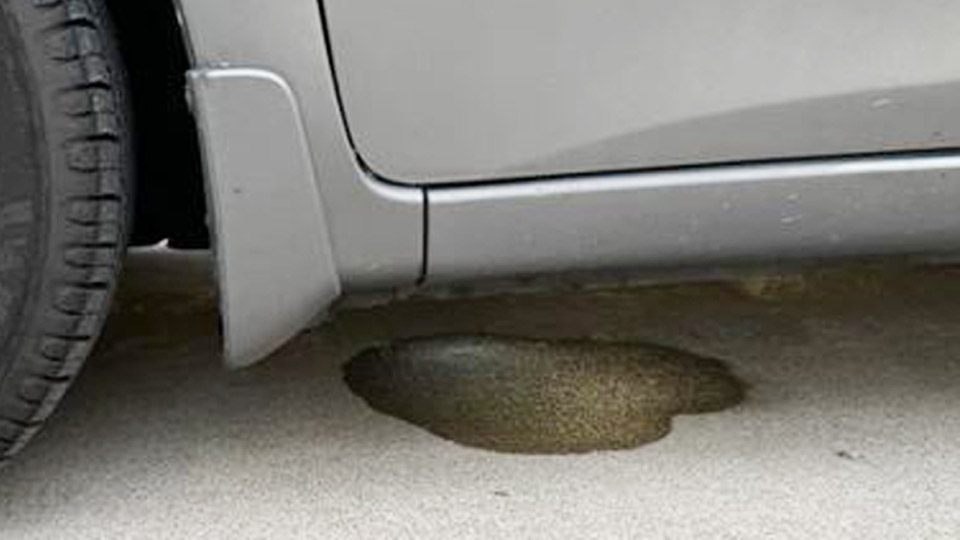Can a Car Leak Fluids After a Rear-End Collision?
You’re stopped at a light, minding your own business, when bam—someone rear-ends you. Your heart’s racing, you check for damage, and then you notice a puddle under your car. That’s exactly what happened to me a few years back when my 2001 Ford Ranger got nudged in traffic. At first, I thought it was no big deal, then I saw fluid dripping from the back.
Rear-end collisions, even minor ones, can cause all sorts of leaks, and they’re not just annoying—they can be dangerous and expensive. Let’s dive into why these leaks happen, what fluids might be involved, and what you should do about it.

Image by reddit
How a Rear-End Collision Affects Your Car
A rear-end collision sends a jolt through your car’s frame and components. Even a low-speed bump can shift things around under the hood or at the rear. I learned this when my Ranger’s fuel tank took a hit, causing a small crack. The impact can loosen fittings, crack housings, or damage seals, leading to leaks.
The rear of a car houses critical systems like the fuel tank, exhaust, and sometimes the differential or cooling components, all of which carry fluids that can escape if something’s knocked out of place.
The severity of the crash matters. A gentle tap might just loosen a hose, but a hard hit could rupture a tank or break a line. I’ve seen cars with crumpled bumpers that looked fine but were leaking like a sieve underneath. The damage isn’t always obvious, so you’ve got to check carefully after any collision.
Common Fluids That Can Leak After a Rear-End Collision
Cars rely on several fluids to run smoothly, and a rear-end collision can cause any of them to leak, depending on what gets damaged. Here’s what I’ve seen go wrong and what to look for:
Fuel (Gasoline or Diesel)
The fuel tank is often at the rear, just under the trunk or back seat. A rear-end collision can crack the tank, damage the fuel lines, or loosen the filler neck. I had a small fuel leak in my Ranger after a crash because the impact cracked the tank’s seam.
Gasoline smells strong and looks clear or slightly yellow. Diesel is thicker and has an oily smell. Fuel leaks are dangerous—they’re flammable and can lead to fires. If you smell gas or see a shiny puddle, don’t drive the car.
Transmission Fluid
If your car has a rear-wheel-drive setup, the transmission or differential is near the rear axle. A collision can damage the transmission pan, differential cover, or fluid lines. Transmission fluid is usually red or pink and feels slick. I helped a friend with a 1998 Chevy Camaro that started leaking transmission fluid after a rear-end hit cracked the differential cover. This kind of leak can cause gears to grind or slip, so it’s a big deal.
Coolant (Antifreeze)
The radiator and coolant reservoir are usually up front, but some cars have coolant lines or components near the rear. A hard hit can crack these or dislodge a hose. Coolant is bright green, pink, or orange and has a sweet smell. I once saw a Jeep Cherokee leak coolant after a rear-end collision because the impact shifted a rear-mounted reservoir. A coolant leak can make your engine overheat, so don’t ignore it.
Brake Fluid
Brake lines run along the car’s undercarriage, and a rear-end collision can bend or crack them. Brake fluid is clear to amber and feels oily. I had a scare with my sister’s Honda Civic when a rear-end crash damaged a brake line, causing a slow leak. You’ll notice spongy brakes or a low brake pedal if this happens. It’s a safety issue, so get it fixed fast.
Power Steering Fluid
Some cars have power steering components or lines near the rear, especially in older models. A collision can damage these, causing a leak. Power steering fluid is usually red or clear and smells like burnt oil. If you lose this fluid, steering gets heavy. I haven’t seen this as often, but it happened to a buddy’s old Dodge after a fender-bender.
Oil
The oil pan is typically under the engine, but a severe rear-end collision can affect oil lines or the rear main seal in some cars. Engine oil is dark brown or black and thick. A leak here can starve the engine of lubrication, leading to major damage. I’ve only seen this in high-speed crashes, but it’s worth checking.
How to Spot a Fluid Leak After a Collision
After my Ranger got hit, I learned to check for leaks right away. Here’s how I do it, and what I recommend you look for:
- Look Under the Car: Park on a clean surface, like a driveway, and check for puddles. Note the color and smell of the fluid.
- Check the Rear: Inspect the fuel tank, differential, and undercarriage for drips or wet spots. A flashlight helps.
- Smell for Clues: Gasoline has a sharp smell, coolant smells sweet, and transmission fluid smells burnt.
- Watch for Warning Signs: Look for warning lights, like the check engine or low coolant light. I missed a coolant warning once and almost cooked my engine.
- Test Drive Carefully: If you suspect a leak, drive slowly and watch for issues like heavy steering, spongy brakes, or overheating.
If you see any fluid, don’t drive until you know what’s leaking and how bad it is. I made the mistake of driving with a small fuel leak, and it was a risky move.
Why Fluid Leaks Are Dangerous
Fluid leaks aren’t just messy—they’re hazardous. Fuel leaks can catch fire, especially near a hot exhaust. I’ve heard horror stories of cars igniting after a small crash. Brake fluid leaks can make your brakes fail, which is terrifying in traffic. Coolant or oil leaks can cause engine damage, leaving you stranded or facing a huge repair bill.
Transmission fluid leaks can ruin your gearbox, and power steering leaks make driving a workout. I’ve seen all of these cause trouble, so take leaks seriously.
What to Do If Your Car Is Leaking After a Collision
When I found the fuel leak in my Ranger, I panicked a bit but followed these steps to sort it out:
- Stop Driving: Pull over safely and turn off the engine. If you smell gas, get away from the car and call for help.
- Identify the Fluid: Check the color, smell, and location of the leak. This helps you know what’s wrong.
- Assess the Damage: Look for cracks, loose hoses, or bent lines. Take pictures for insurance.
- Call a Tow Truck: If the leak is fuel, brake fluid, or anything major, don’t drive. Get it towed to a mechanic.
- Visit a Mechanic: A pro can diagnose and fix the issue. My Ranger needed a new fuel tank, which cost about $400.
- File an Insurance Claim: If the collision wasn’t your fault, the other driver’s insurance might cover repairs. I got my repair costs covered this way.
Don’t try to fix major leaks yourself unless you’re experienced. Fuel and brake fluid leaks are especially tricky and dangerous.
Repair Costs for Fluid Leaks
Fixing a leak depends on what’s damaged. Here’s a table of typical costs based on my experience and talking to mechanics:
| Fluid Type | Common Issue | Estimated Cost (USD) |
|---|---|---|
| Fuel | Cracked tank or fuel line | $200–$800 |
| Transmission Fluid | Damaged differential or pan | $150–$500 |
| Coolant | Cracked reservoir or hose | $100–$400 |
| Brake Fluid | Bent or cracked brake line | $100–$300 |
| Power Steering Fluid | Damaged line or fitting | $100–$250 |
| Oil | Cracked oil pan or seal | $200–$600 |
These are rough estimates. Costs vary by car model, labor rates, and damage severity. My Ranger’s fuel tank replacement was on the lower end because I found a used part, but new tanks for some cars can be pricey.
Preventing Leaks After a Collision
You can’t always avoid a rear-end collision, but you can reduce the risk of leaks. I’ve learned a few tricks to keep my cars in top shape:
- Regular Maintenance: Check fluid levels and inspect hoses regularly. Weak hoses are more likely to break in a crash.
- Use Quality Parts: Cheap aftermarket fuel tanks or lines can crack easier. I stick with OEM or trusted brands like Dorman.
- Drive Defensively: Keep a safe distance from other cars to avoid collisions. I’ve dodged a few rear-enders by watching my mirrors.
- Get Inspections: After any crash, even a minor one, have a mechanic check for hidden damage. I missed a slow coolant leak once because I didn’t look closely enough.
Common Myths About Fluid Leaks
I’ve heard some wild ideas about leaks after collisions. Let’s set the record straight:
Myth: A small leak is no big deal.
Truth: Even a tiny fuel or brake fluid leak can lead to fires or brake failure. Fix it fast.
Myth: Only hard crashes cause leaks.
Truth: Even a 5-mph bump can loosen a hose or crack a weak tank.
Myth: All puddles under a car are bad.
Truth: Some condensation from the AC is normal, but oily or colorful fluids are trouble.
Tips for Dealing with Insurance
If another driver caused the collision, their insurance should cover your repairs. Here’s what I do to make the process smoother:
- Document Everything: Take pictures of the damage, the leak, and the crash scene. I always snap a few extra shots for proof.
- Get a Police Report: It helps with insurance claims, especially if the other driver disputes fault.
- Keep Receipts: Save all repair bills and towing costs. My Ranger’s repair was fully covered because I had clear records.
- Be Honest: Tell the insurance company exactly what happened. Exaggerating can backfire.
Why Even Minor Collisions Need Attention
I used to think a little bump wasn’t worth worrying about, but my Ranger’s fuel leak changed my mind. Even minor rear-end collisions can cause hidden damage. A loose hose or hairline crack might not leak right away but can worsen over time. I’ve seen cars driven for weeks after a crash, only to have a major leak strand the driver. Get your car checked, even if it looks fine on the surface.
My Personal Experience with Leaks
That fuel leak in my Ranger was a wake-up call. The crash wasn’t even that bad—just a tap at a stoplight—but it was enough to crack the tank. I smelled gas, saw a small puddle, and knew I couldn’t drive it. Towing it to the shop cost $75, and the new tank and labor set me back $400.
Insurance covered it, but it was a hassle. Since then, I always check under my car after any bump, no matter how small. It’s saved me from bigger headaches, like when I caught a slow brake fluid leak in my wife’s SUV after a parking lot incident.
Conclusion
A rear-end collision can turn your day upside down, and finding a fluid leak under your car only makes it worse. Whether it’s fuel, transmission fluid, coolant, or something else, leaks are a sign your car needs attention. From my own mishaps, I’ve learned that checking for leaks right after a crash, identifying the fluid, and getting it fixed fast can save you from danger and costly repairs.
Don’t let a small drip turn into a big problem—pop the hood, grab a flashlight, and take a look. Your car’s safety, and your peace of mind, are worth it. Keep driving smart, and you’ll keep those leaks at bay.
Frequently Asked Questions
Can a car leak fluids after a rear-end collision?
Yes. A collision can damage the fuel tank, transmission, coolant lines, brake lines, or other components, causing leaks.
What fluids might leak after a rear-end crash?
Fuel, transmission fluid, coolant, brake fluid, power steering fluid, or oil can leak, depending on what’s damaged.
How do I know if my car is leaking fluid after a collision?
Check for puddles under the car, smell for gasoline or sweet coolant, and look for warning lights or performance issues.
Is it safe to drive with a fluid leak?
No. Fuel and brake fluid leaks are especially dangerous. Other leaks can cause engine damage or poor handling. Get it checked immediately.
How much does it cost to fix a fluid leak after a crash?
Costs range from $100 for a simple hose fix to $800 for a new fuel tank, depending on the damage and car model.
Can a minor rear-end collision cause a leak?
Yes. Even a low-speed bump can loosen hoses or crack weak components, leading to leaks.
What should I do if I find a leak after a collision?
Stop driving, identify the fluid, and get the car towed to a mechanic. Document the damage for insurance.

David Peterson, the chief editor of sparepartscare. I am an automobile engineer and assign to an local firm with much experience in automobile equipment. During the time, most of my experience is related to the Industry of cars parts. I learned about the thing, when working with experienced inspectors, one must be as good as the inspector, or better, with knowledge of the project as well as the practical aspects of automobile industry.












